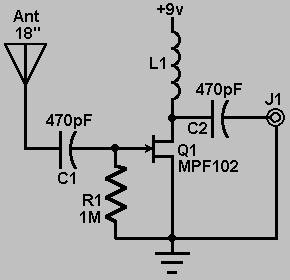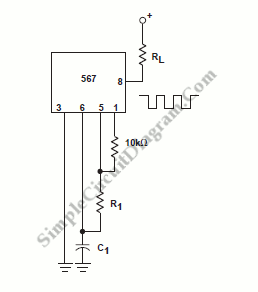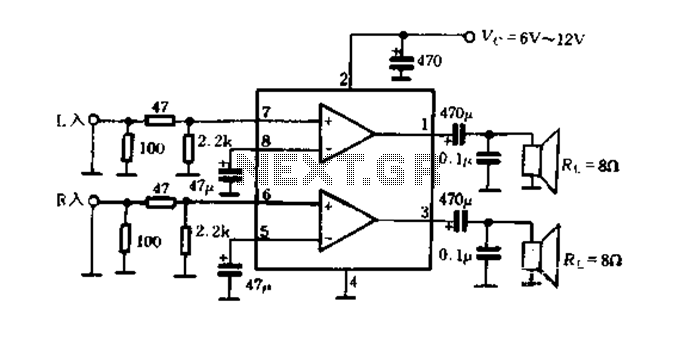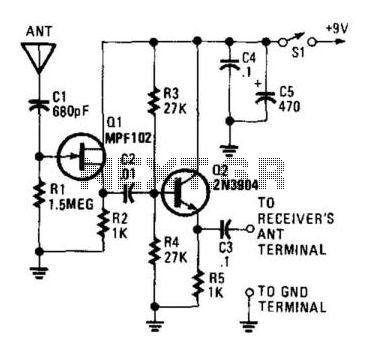
Active Plug Classic
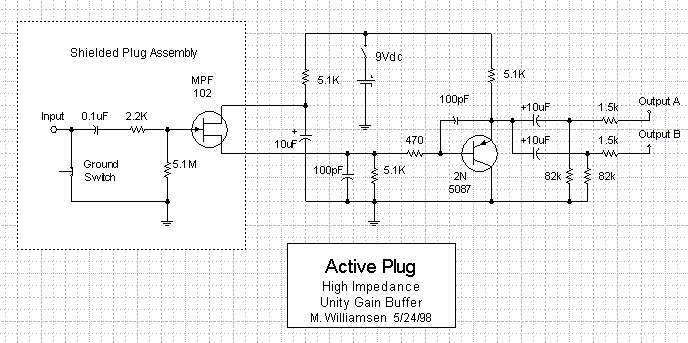
A FET impedance converter is designed for use with the Fishman pickup on a Kay orchestra bass. The circuit is divided into two sections, allowing the input section to be mounted inside the head shell of a 1/4" plug, placing the active circuitry directly on the instrument. Two isolated output circuits are depicted, but additional outputs can be included. The prototype utilized in performance features three outputs: 1/4" phone, RCA phono, and XLR. For the XLR output, a TRW/UTC #O-2 mic-line transformer is used within a #O-17 magnetic shield to achieve lower output impedance. An enhanced version of this circuit, which offers improved headroom and reduced harmonic distortion, can be found on the Active Plug Bootstrap page. In applications where battery power is unnecessary, a Vacuum Tube Direct Interface has been developed, employing triaxial cable for instrument connection. The circuit is optimized for low current drain with a single 9 Volt power supply, maintaining distortion at 1% or less up to 1 Volt RMS output. The gain is set at unity, ensuring stability with transient inputs and compatibility with most instrument and sound reinforcement amplifier inputs. The frequency response is flat without equalization, making it versatile for various instruments. Equalization, if required, can be applied on the mixing board or instrument amplifier. The JFET input circuit can be mounted on a Switchcraft SilentPlug 1/4" phone plug, along with a battery box housing additional circuitry and the mic-line transformer. Magnetic pickups, which consist of many turns of fine copper wire around a permanent magnet, are commonly found on solid body electric guitars and basses. These pickups are highly inductive and necessitate impedance conversion before connecting to line-level circuits. This conversion can be achieved through onboard active circuitry, which effectively isolates the pickup impedance from the adverse effects of potentiometer resistance and cable capacitance. Alternatively, it may be performed in an outboard preamp or instrument amplifier, where potentiometer resistance and cable capacitance can diminish high-frequency signal components. The use of an Active Plug impedance converter mitigates cable capacitance issues but does not rectify losses caused by onboard potentiometers. Piezo pickups, which are pressure-sensitive ceramic elements attached to the bridge or other vibrating parts of the instrument, are frequently employed on hollow body guitars and classical instruments. These pickups are primarily capacitive and also require impedance conversion prior to connection with line-level circuits. Most preamps and instrument amplifiers lack sufficient input impedance for these devices, which typically demand a minimum load of 5 megOhms. Cable capacitance impacts all signal components, while load resistance can attenuate low frequencies. Consequently, applications often necessitate onboard active electronics or a specialized high-impedance direct box, such as the Active Plug described. Additionally, there exists a specific type of piezo transducer, a ceramic microphone installed inside certain instruments like accordions. These installations were predominantly implemented before the advent of solid-state amplifiers, relying on the high input impedance of tube amplifiers and preamps for optimal sound quality. Connecting such instruments to modern sound mixing boards may result in a raspy or tinny sound. A high-impedance direct box can significantly enhance performance in this scenario.
The FET impedance converter circuit is structured to accommodate the unique electrical characteristics of both magnetic and piezo pickups, ensuring optimal signal integrity and compatibility with various amplification systems. The design prioritizes low power consumption, stability, and a flat frequency response, making it a versatile solution for musicians seeking to maintain the fidelity of their instruments' sound. The inclusion of multiple output options enhances its utility, allowing musicians to interface with different audio equipment seamlessly. The careful selection of components, such as the mic-line transformer and the use of high-quality cabling, further contributes to the circuit's performance, ensuring that the nuances of each instrument are preserved during amplification. This impedance converter is particularly advantageous in live performance settings, where reliability and sound quality are paramount.A FET impedance converter for use with the Fishman pickup on my Kay orchestra bass. As shown in the schematic below, the circuit is divided into two sections, so that the input section can be mounted inside the head shell of a 1/4" plug. This puts the active circuitry right were it counts, on the instrument. Two isolated output circuits are shown, but you can have more. The prototype I use in performance has three outputs: 1/4" phone, RCA phono, and XLR. For the XLR output, I used a TRW/UTC #O-2 mic-line transformer, inside a #O-17 magnetic shield, to get even lower output impedance. For an improved version of this circuit with better headroom and reduced harmonic distortion, see my Active Plug Bootstrap page.
For applications where battery power isn`t required, I`ve also developed a Vacuum Tube Direct Interface, using triaxial cable to connect to the instrument. The circuit is optimized for low current drain with a single 9 Volt power supply. Distortion is 1% or less up to 1 Volt RMS output. Gain is set at unity, which makes the circuit very stable with transient inputs, and matches up well with most instrument and sound reinforcement amplifier inputs.
With no equalization provided, frequency response is flat allowing the circuit to be used with almost any instrument. Equalization, if needed, can be done on the mixing board or instrument amplifier. Here are some snapshots of the JFET input circuit mounted on a Switchcraft SilentPlug 1/4" phone plug, and of the battery box with additional circuitry and mic-line transformer.
Magnetic pickups, consisting of many turns of fine copper wire wrapped around a permanent magnet, are found on almost all solid body electric guitars and basses. They are highly inductive, and require an impedance conversion before being connected to line level circuits.
The conversion may be done by onboard active circuitry which effectively isolates the impedance of the pickups from the harmful effects of potentiometer resistance and cable capacitance. Or it may be done in an outboard preamp or instrument amplifier, allowing potentiometer resistance and cable capacitance to absorb high frequency components of the signal.
Use of an Active Plug impedance converter will overcome cable capacitance, but can`t help losses due to potentiometers inside your instrument. Piezo pickups, consisting of pressure sensitive ceramic elements clipped to the bridge or other portion of the instrument where vibrations can be sensed, are commonly used on hollow body guitars and classical instruments.
They are primarily capacitive, and also require an impedance conversion before connection to line level circuits. Most preamps and instrument amplifiers don`t have a high enough input impedance to manage these devices, which typically require a load of not less than 5 megOhms.
Cable capacitance reduces all components of the signal, while load resistance cuts out low frequencies. Most applications therefore must have either onboard active electronics, or a special high impedance direct box, like the Active Plug described above.
There is a special kind of piezo transducer you should be aware of, which is a ceramic microphone mounted inside certain instruments like accordians. These installations were mainly done in an era well before solid state amplifiers were available, and relied on the typically high input impedance of tube amps and preamps for good sound.
If you plug one of these instruments into a modern sound mixing board, it will sound raspy or tinny. A high impedance direct box can make a big difference in this application. 🔗 External reference
The FET impedance converter circuit is structured to accommodate the unique electrical characteristics of both magnetic and piezo pickups, ensuring optimal signal integrity and compatibility with various amplification systems. The design prioritizes low power consumption, stability, and a flat frequency response, making it a versatile solution for musicians seeking to maintain the fidelity of their instruments' sound. The inclusion of multiple output options enhances its utility, allowing musicians to interface with different audio equipment seamlessly. The careful selection of components, such as the mic-line transformer and the use of high-quality cabling, further contributes to the circuit's performance, ensuring that the nuances of each instrument are preserved during amplification. This impedance converter is particularly advantageous in live performance settings, where reliability and sound quality are paramount.A FET impedance converter for use with the Fishman pickup on my Kay orchestra bass. As shown in the schematic below, the circuit is divided into two sections, so that the input section can be mounted inside the head shell of a 1/4" plug. This puts the active circuitry right were it counts, on the instrument. Two isolated output circuits are shown, but you can have more. The prototype I use in performance has three outputs: 1/4" phone, RCA phono, and XLR. For the XLR output, I used a TRW/UTC #O-2 mic-line transformer, inside a #O-17 magnetic shield, to get even lower output impedance. For an improved version of this circuit with better headroom and reduced harmonic distortion, see my Active Plug Bootstrap page.
For applications where battery power isn`t required, I`ve also developed a Vacuum Tube Direct Interface, using triaxial cable to connect to the instrument. The circuit is optimized for low current drain with a single 9 Volt power supply. Distortion is 1% or less up to 1 Volt RMS output. Gain is set at unity, which makes the circuit very stable with transient inputs, and matches up well with most instrument and sound reinforcement amplifier inputs.
With no equalization provided, frequency response is flat allowing the circuit to be used with almost any instrument. Equalization, if needed, can be done on the mixing board or instrument amplifier. Here are some snapshots of the JFET input circuit mounted on a Switchcraft SilentPlug 1/4" phone plug, and of the battery box with additional circuitry and mic-line transformer.
Magnetic pickups, consisting of many turns of fine copper wire wrapped around a permanent magnet, are found on almost all solid body electric guitars and basses. They are highly inductive, and require an impedance conversion before being connected to line level circuits.
The conversion may be done by onboard active circuitry which effectively isolates the impedance of the pickups from the harmful effects of potentiometer resistance and cable capacitance. Or it may be done in an outboard preamp or instrument amplifier, allowing potentiometer resistance and cable capacitance to absorb high frequency components of the signal.
Use of an Active Plug impedance converter will overcome cable capacitance, but can`t help losses due to potentiometers inside your instrument. Piezo pickups, consisting of pressure sensitive ceramic elements clipped to the bridge or other portion of the instrument where vibrations can be sensed, are commonly used on hollow body guitars and classical instruments.
They are primarily capacitive, and also require an impedance conversion before connection to line level circuits. Most preamps and instrument amplifiers don`t have a high enough input impedance to manage these devices, which typically require a load of not less than 5 megOhms.
Cable capacitance reduces all components of the signal, while load resistance cuts out low frequencies. Most applications therefore must have either onboard active electronics, or a special high impedance direct box, like the Active Plug described above.
There is a special kind of piezo transducer you should be aware of, which is a ceramic microphone mounted inside certain instruments like accordians. These installations were mainly done in an era well before solid state amplifiers were available, and relied on the typically high input impedance of tube amps and preamps for good sound.
If you plug one of these instruments into a modern sound mixing board, it will sound raspy or tinny. A high impedance direct box can make a big difference in this application. 🔗 External reference

